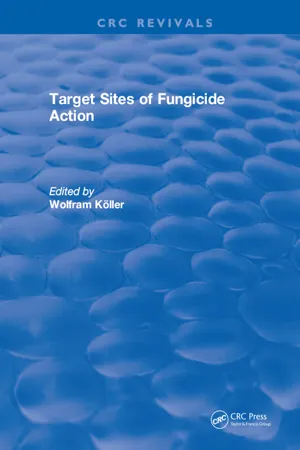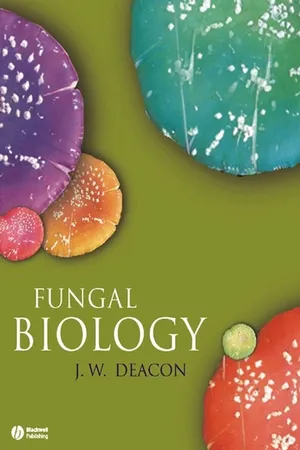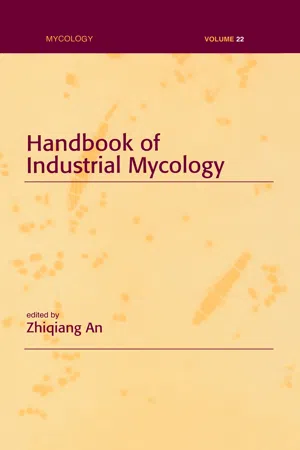Biological Sciences
Antifungal
Antifungal refers to substances or medications that are used to treat or prevent fungal infections. These can include topical creams, oral medications, or intravenous treatments. Antifungals work by targeting the fungal cells and inhibiting their growth or killing them, helping to alleviate symptoms and eradicate the infection.
Written by Perlego with AI-assistance
Related key terms
4 Key excerpts on "Antifungal"
- eBook - ePub
- Wolfram Koeller(Author)
- 2018(Publication Date)
- CRC Press(Publisher)
12 Future antimycotic drugs must be fungal specific to warrant a long-term treatment of internal mycoses without side effects on the patient. Scientists engaged in the discovery of new Antifungal agents might be advised to cross disciplines more frequently in the future.Most of our modern fungicides and Antifungal drugs have been found via random synthesis, biological screening, and empirical optimization of lead structures. Some have been derived from natural product screening, an approach not fundamentally different from random synthesis. The modes of action of particular Antifungal groups were only identified in the late stages of development. Most often, this initial biochemical work was done by scientists at academic institutions and, thus, outside corporate research. Undoubtedly, the “screening approach” has been remarkably successful in the past, and the role and importance of molecular tools in the discovery of new Antifungal inhibitors is not immediately apparent. It is certainly justified that the “traditional” way of fungicide discovery and the eminent importance of appropriate and reliable screening systems and methods have been emphasized in recent reviews.13 , 14 Regardless of the undisputed merits of random synthesis and screening, however, continuous biochemical studies have yielded valuable contributions to fungicide discovery programs, in particular in the group of sterol demethylation inhibitors (Chapter 7 ) with a mode of action identified in 1974 and under continuous development for more than two decades.15 , 16 , 17 , 18 - eBook - ePub
- Mahmoud Ghannoum, Matthew Parsek, Marvin Whiteley, Pranab K. Mukherjee(Authors)
- 2015(Publication Date)
- ASM Press(Publisher)
19 From Biology to Drug Development: New Approaches to Combat the Threat of Fungal BiofilmsCHRISTOPHER G. PIERCE,1 , 3 ANAND SRINIVASAN,2 , 3 ANAND K. RAMASUBRAMANIAN,2 , 3 and JOSÉ L. LÓPEZ-RIBOT1 , 3INTRODUCTION
Advances in modern medicine are prolonging the lives of severely ill individuals; however, at the same time they are creating an expanding population of compromised patients at increased risk of suffering from invasive fungal infections (1 ). These include surgical, transplant, cancer, intensive care unit, and HIV-infected patients, as well as neonates. The use of broad-spectrum antibiotics, parenteral nutrition, medical implant devices, and immune suppression, as well as disruption of mucosal barriers due to surgery, chemotherapy, and radiotherapy represent the most important predisposing factors for these infections. Unfortunately, the mortality rates associated with these fungal infections remain unacceptably high, which clearly points to the many limitations of current Antifungal therapy, including the limited armamentarium of Antifungal agents, their inherent toxicity, and the emergence of resistance (2 –4 ). Fungi are eukaryotic organisms, and there is a paucity of selective targets which can be exploited for Antifungal drug development, while at the same time this is also the main reason for the elevated toxicity of some of the current agents (2 , 3 , 5 ). Only three classes of Antifungal agents—azoles, polyenes, and echinocandins—constitute the mainstay of Antifungal therapy for patients with life-threatening invasive fungal infections. Moreover, the Antifungal drug pipeline is mostly dry and, with the exception of isavuconazole, no new agents are expected to reach the market any time soon (2 ).The formation of biofilms by many pathogenic fungi further complicates treatment (4 ). Biofilms are attached and structured microbial communities surrounded by a protective exopolymeric matrix (6 –8 ). Once formed, these biofilms can initiate or prolong infections by providing a safe haven from which cells can invade local tissue, seed new infection sites, resist eradication efforts, and also lead to failure of implanted medical devices (9 , 10 ). For example, yeasts, and in particular Candida spp., are now the third most common microorganisms associated with catheter-related bloodstream infections (11 - eBook - ePub
- J. W. Deacon(Author)
- 2013(Publication Date)
- Wiley-Blackwell(Publisher)
Similarly, the naturally occurring Antifungal antibiotic griseofulvin was first discovered as a “curling factor” that caused the germ-tubes of a plant-pathogenic fungus, Botrytis allii, to grow in a distorted spiral fashion, but it was developed commercially as an orally administered antibiotic to control infections caused by the dematophytic fungi. It acts by disrupting fungal microtubules, and this explains its morphogenetic effect because microtubules are involved in the delivery of cellular components to the growing hyphal tip (Chapter 4). Principal cellular targets of Antifungal agents The main cellular targets currently used to control plant or human diseases are shown in Fig. 17.2. At first sight it might seem that there are a large number of cellular targets that could be exploited for disease control. But in practice the range is limited. Many of the compounds shown in Fig. 17.2 have a very restricted usage (shown as “R”) and are used mainly in Japanese agriculture. If we exclude these compounds then we are left with just five main types of Antifungal target : 1 the cell membrane, because fungi are unique in having ergosterol as their characteristic membrane sterol; 2 the microtubules and microtubule-associated proteins, which are disrupted by the antibiotic griseofulvin, and by benzimidazole fungicides (which have now been withdrawn); 3 mitochondrial respiration, which is targeted by some plant fungicides; 4 fungal cell wall components, especially β1-3 glucans, for which a new group of drugs, the echinocandins, has recently come into use (2002); 5 various aspects of general metabolism. Fig. 17.2 The main cellular targets for chemical control of fungi that cause plant and human diseases - eBook - ePub
- Zhiqiang An(Author)
- 2004(Publication Date)
- CRC Press(Publisher)
3 ].An astounding number of fungal metabolites with Antifungal activity have been described in the literature over the last 10 years. Actually, the most recent drug based on a fungal metabolite that has reached the market at the time of preparation of this manuscript is the Antifungal agent Cancidas® (caspofungin acetate; Merck). Most Antifungal compounds described from fungi have been discovered by using non-mode-of-action based screens, that is, by simply looking for compounds able to inhibit the growth of a target yeast or filamentous fungus. Griseofulvin, a metabolite produced by Penicillium spp. discovered in 1939, which has been used in the clinic for several decades to treat skin infections by fungal dermatophytes, was discovered using this strategy, and its mode of action remains unclear even today [4 ]. Comparatively speaking, the number of Antifungal compounds for which the mechanism of action is known is small. These will be the subject of the remainder of this section.2.1. Cell Wall
One of the targets for novel Antifungals under active investigation is the fungal cell wall. Antifungal agents acting on this target are expected to be inherently selective and should have fungicidal features that make them particularly attractive for clinical development. At present, glucan synthesis is the only process of cell wall synthesis that has been used successfully for the development of a new drug product. Glucan is a polysaccharide built of glucose monomers linked by (1,3)-(β or (1,6)-β bonds, and it is an essential component of the cell wall, guaranteeing many of its physical properties [5 ]. Inhibitors of glucan synthesis have been shown to possess Antifungal activity in vitro as well as in vivo in many different animal models. The most classic examples of inhibitors of glucan synthesis are the echinocandins, cyclic hexapeptides N-acylated with an aliphatic chain of different length [6 ]. Structural variants arise from different substitution patterns on the hexapeptide ring or in the fatty acid side chain. Since the first echinocandin was discovered in the early 1970s, many members of the family have been discovered in diverse fungi [6 , 7
Learn about this page
Index pages curate the most relevant extracts from our library of academic textbooks. They’ve been created using an in-house natural language model (NLM), each adding context and meaning to key research topics.



